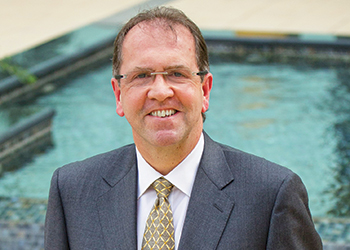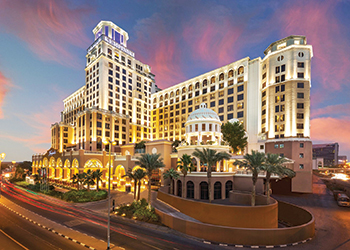Best of both worlds
01 March 2016
Following a $100-million facelift, Dubai’s iconic Kempinski Hotel Mall of the Emirates now offers a ‘hotel within a hotel’
The Kempinski Hotel Mall of the Emirates will bring the best of both worlds – a winter wonderland and the sunshine and beaches of the Arabian Gulf – when the final phase of its extensive renovation is opened next month (April).
The hotel – one of Dubai’s most iconic and famous – first opened to the public a decade ago and enjoys a strategic location, being connected to the prestigious Mall of the Emirates in Dubai. A three-phased renovation programme was initiated four years ago to cement its position as a leading luxury hotel destination in the UAE and introduce exceptional new food and beverage offerings.
Following completion of key aspects of the project, the owner of the property Majid Al Futtaim unveiled the refurbished hotel in December 2015.
The Dh368-million ($100.2 million) renovation programme was launched in January 2012 with the redevelopment of the ground floor mall interface, the main ground lobby and guest arrival areas and finishing with the guestrooms. The hotel has remained open for the entire duration of the project with the impact on guests being mitigated through careful and thoughtful construction planning.
The project has seen the renovation of the entire hotel including the 393 guest rooms, suites and luxury chalets, which now include state-of-the-art technology allowing guests to control their television, order room service, make a restaurant reservation, book a spa treatment and access Mall of the Emirates information, its offering and promotions all via an in-room iPad.
It also included the expansion of the conference and catering facilities, the opening of three new restaurants and lounges; in addition to the full refurbishment of the hotel façade, new façade lighting design, new hotel signage installations and expansion of the executive lounge.
 |
|
Barlow ... Kempinski facelift. |
“We also improved the guest arrival experience with an expanded porte cochere and a bright and elegant main lobby and mall connection,” says Simon Barlow, CEO of Hotels at Majid Al Futtaim Properties.
In addition to a new level of guestroom luxury, the expansion has added three new vibrant food and beverage outlets – Salero Tapas and Bodega, Olea, and Noir. The latter two are linked with a large external terrace. The redevelopment of the food and beverage outlets has doubled the size and capacity of the hotel’s restaurant and bar offerings, and has activated the previously unused external terrace areas.
Also added are two state-of-the-art 18-seat executive boardrooms, plus additional meeting room capacity.
The final phase of renovation will see the opening next month of the charming Aspen Ski Chalets, which overlook the wintery slopes of Ski Dubai at the Mall of the Emirates, and Aspen Pool Chalets, which overlook the calming waters of the private swimming pool. Both offer a personal butler service and a hassle-free no check-in process.
“As part of the refurbishment project, we have created a hotel-within-a-hotel, called Aspen Chalets. This comprises 15 luxuriously appointed and themed Aspen Ski Chalets and five themed Aspen Pool Chalets. The chalets boast all the comforts of a ski lodge, with the warmth of Kempinski’s world-class service,” says Barlow.
Uniquely, the chalets have been designed by Wimberly Interiors as a contrast between snow and sun.
 |
|
The crystal chandeliers ... a nod to glistening icicles. |
The project
The client’s brief was extensive and took into account guest feedback, operator requirements and new Department of Tourism and Commerce Marketing (DTCM) classification requirements, among other aspects. The aim was to create a timeless and elegant guest experience with a strong sense of place and linkage back to the snow and ice of Ski Dubai. The completed design also had to ensure the hotel remained current and at the top of its competitive set, particularly with the increase in supply of five-star and luxury hotels.
Majid Al Futtaim Hotels’ local market knowledge and experience has facilitated the creation of unique, contemporary and authentic concept designs that are closely connected to the sense of place and local heritage, according to Barlow.
He says the new design scheme played upon the contrasting worlds of the sub-zero snow experience of Ski Dubai and the warm waters of Dubai’s Arabian Gulf.
The snow and ice was interpreted in various elements inside the hotel whilst the sense of place is reinforced through original art installations. The guestrooms, suites and chalets each has its own identity, yet are cohesive in that they complement the design theme.
He adds: “The guestroom interior palette utilises ice blues and silver contrasted with warm and textural neutrals, bringing a timeless elegance to the hotel. The crystal chandeliers are a nod to glistening icicles. The suites’ interiors build upon the guestroom palette, adding warm blues, gold and silver metals with rich stone and onyx. The bathrooms feature garden tubs and luxurious showers, and the kitchens feature Miele appliances. A rather unique element of the suites is their impressive display of original art commissioned from regional artists.”
The Aspen Ski Chalets with their impressive view of Ski Dubai make the ski experience the focal point. Each chalet has a stone fireplace, luxurious furnishings, accents of natural woods, stone and marble. The interior is inspired by the ski lodges of Aspen with a cosy, comfortable, residential feel enhanced by textural elements, while the amenities and appointments of the chalets elevate the guest experience to a level not seen before in Dubai.
In contrast, the Aspen Pool Chalets, which open directly to the pool, have a styling which is light and airy with neutral colours and textures inspired by Florida Keys.
Majid Al Futtaim operates an integrated retail, leisure and entertainment business model, with each business unit designed to not only consistently deliver exceptional experiences to its customers but add value to the customers of other business units.
 |
|
Salero Tapas and Noir (below) ... two of the three new F&B outlets. |
“In this case, the refurbishment of the Kempinski Hotel, which is connected to the award-winning Mall of the Emirates, was designed to cement the hotel’s position as a leading luxury hotel destination in the UAE, while offering new exceptional food and beverage experiences to the customers of the hotel, mall and the wider community. This has been acknowledged with the new restaurant ‘Olea’ achieving Number One ranking out of 8,694 restaurants via Tripadvisor within two months of opening,” he says.
The refurbishment also sought to reset the ‘lifecycle clock’ on the front-of-house (FOH) and guestroom areas. Some key achievements of the refurbishment included the conversion of back-of-house (BOH) and mall toilets into lobby areas and a new food and beverage venue and of the manager’s apartment into two 18-seat boardrooms.
It also involved installing new lifts through existing FOH areas, doubling the capacity of the hotel’s Level Two, expanding the capacity of the Level 11 executive lounge, installing additional architectural detail to the hotel façade and enhancing the thermal performance of the building.
All the guestrooms and corridors underwent soft and hard refurbishment, which has included the installation of new bathroom fixtures.
To ensure timely delivery, Barlow says the project team established a robust logistical plan for the guestroom scope. Each working cycle had a set programme of 75 days with guestroom floors handed back to the operator in phases to ensure that no more than one-third of the total hotel inventory was affected by the renovation works at the same time.
“The efficiency of the renovation was reflected by several early completions. Olea restaurant was completed four weeks earlier than scheduled, Noir bar and cocktail lounge was completed 10 days earlier than scheduled, and the guestrooms were completed 10 days earlier than scheduled,” he explains.
 |
|
|
The DNA of Majid Al Futtaim to drive innovation into every aspect of the business is apparent in the execution of the project. For instance:
• The design team created special guest moments throughout the hotel via original and regional artworks that showcase the Middle East’s culture. Installations included ‘Snow Drift’ by Solomon and Wu, a 103-sq-m plaster sculpted installation; and ‘Drift’ by Giles Miller Studio, a 9-m-high sculptural installation suspended in the main lobby behind the reception desk.
In line with Majid Al Futtaim focus on sustainability and thanks to this detail-orientated and disciplined approach to the refurbishment, the hotel was awarded Leed EBOM status following the completion of the renovation.
A number of innovative ideas were implemented throughout the project execution, some of which included:
• Introduction of an innovative waterproofing system that was lightweight, improved installation times, removed the need for wet trades, provided a 25-year warranty and could be deployed through the training of non-skilled labour.
• Construction of purpose-built platforms to operate from the existing building maintenance unit rails plus rope access for painting as opposed to scaffolding. This solution minimised the impact on the hotel and reduced construction costs.
The materials used included book-matched marble floors, marble, timber, accent wall paper, original floor carpets, leathers and crystal chandeliers, to name a few.



